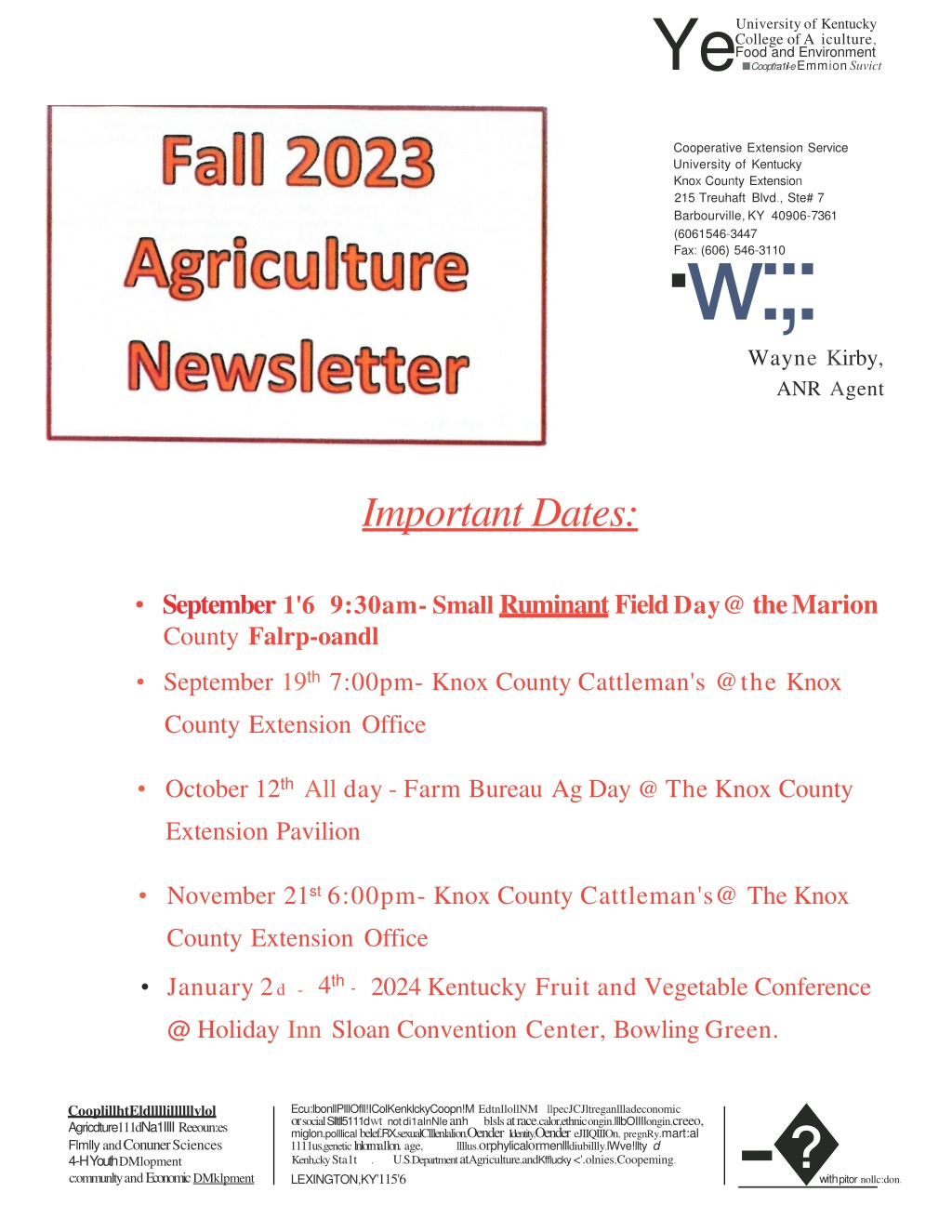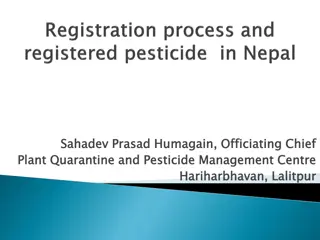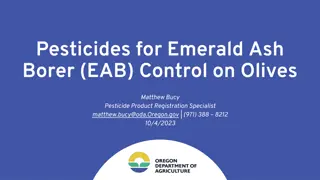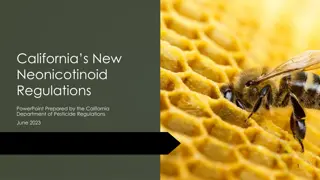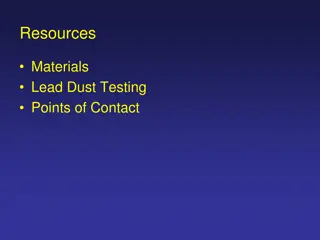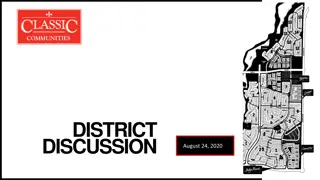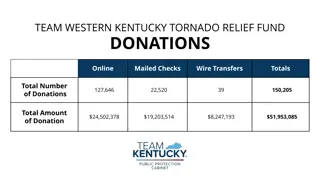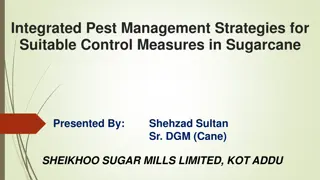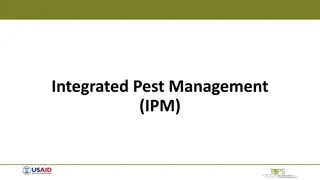Best Management Practices for Homeowners Using Pesticides
Pesticides are important tools for managing pests, but using them correctly is crucial for safety and effectiveness. Homeowners should follow best management practices, such as reading and understanding label instructions, using pesticides only when needed, and selecting products with low toxicity. Cultural controls should be considered first, and pesticides used as a last resort. Regular monitoring, proper application timing, and wearing appropriate protective gear are also essential for safe pesticide use.
Download Presentation

Please find below an Image/Link to download the presentation.
The content on the website is provided AS IS for your information and personal use only. It may not be sold, licensed, or shared on other websites without obtaining consent from the author. Download presentation by click this link. If you encounter any issues during the download, it is possible that the publisher has removed the file from their server.
E N D
Presentation Transcript
Ye. Coopt'ra1ile Emmion Suvict University of Kentucky College of A iculture, Food and Environment Cooperative Extension Service University of Kentucky Knox County Extension 215 Treuhaft Blvd., Ste# 7 Barbourville, KY 40906-7361 (6061546-3447 Fax: (606) 546-3110 w:;: Wayne Kirby, ANR Agent Important Dates: September 1'6 9:30am- Small Ruminant Field Day@ the Marion County Falrp-oandl September 19th 7:00pm- Knox County Cattleman's @the Knox County Extension Office October 12th All day - Farm Bureau Ag Day @ The Knox County Extension Pavilion November 21st 6:00pm- Knox County Cattleman's@ The Knox County Extension Office 4th - January 2 d - 2024 Kentucky Fruit and Vegetable Conference @ Holiday Inn Sloan Convention Center, Bowling Green. - CooplillhtEldllllillllllvlol Agricdture111dNa1IIII Reeoun:es Flmlly and Conuner Sciences 4-H Youth DMlopment c:ommunlty and Economic DMklpment Ecu:lbonllPlllOfll!IColKenklckyCoopn!M EdtnllollNM llpecJCJltreganllladeconomic or social Slltll5111d wt not di1alnNle anh blsls at race.calor,ethnic ongin,lllbOIIIIongin,creeo, miglon.polllical belef.RX.sexualClllenlalion.Oender Identity,Oender eJIIQIIIOn, pregnRy.mart:al 1111us,genetic lnlorma1lon. age, llllus.orphylicalormenllldiubillly.lWve!llty d Kenh,cky Sta1t . U.S.Department atAgriculture,andKfflucky <'.olnies,Coopeming. LEXINGTON,KY'115'6 with pitor nollc:don.
Pesticide Use - Best Management Practices for Homeowners Pesticides for purchase al local stores or onhne to anyone are referred to as 'General Use or unclassified pesticides by the EPA. You do not need a license or certification to purchase and use these on your own property. Although these are considered General Use and are inherently less hazardous than Restricted Use Pesticides (RUPs), used incorrectly they can be harmful to people and/or the environment. Before purchasing and h,:t,,,..using a pesticide, you need to read and understand the label instructions. By following these instructions, you can be reassured you arc using the pesticide properly and safely. Pesticides are used to manage pests, including weeds, insects. plant diseases, and others. But pesticides are just one type of management tactic usually used after other management tactics are employed. These other tactics are preventative and are often referred to as cultural controls; examples include planting resistant varieties, sanitation, altering planting dates lo avoid pests. improving d r a i e andair movement. h sical barriers (landscape fabric. row covers, mulch). pruning and hand removal, and rotation. Pesticide Best Management Practices When these other tactics are not sufficient to keep pest problems at a tolerable level. pesticides are sometimes used. Here are some basic best management practices for homeowners when using pesticides. If you have had past problems with specific pests or diseases. see if there are cultural controls that can be used to avoid the problem. Regularly monitor your plants to identify pest problems early. It is always easier to control problems early than wailing until they become critical. Generally. it is good to check plants at least once a week when conditions favor pest development_. Be able to identify what you find or take it to your county Extension office (ifs free m Kentucky!). Use pesticides only when needed and follow ALL label instructions. Only use them at rates listed on the label. Too high a rate is unsafe. too little may encourage development of resistance by pest populations. If a pesticide is needed, carefully match the pesticide with the type of pest to be controlled. For example. any one herbicide only controls some weeds. just as a fungicide v,lill only manage certain disease problems. Select pesticides with low toxicity to humans and other non-target organisms. such as pets and polhnators. Do not use pesticides around the home when the label states 'Not for home use.' Make certain that the types of plants being treated are listed on the label. Some pesticides may injure sensitive plants or leave unwanted residues on produce. If a pesticide is needed, it must be applied at the right time. With herbicides, this may be before weeds reach a certain stage or height. with diseases this may be before plants become infected. and with insects this may be before they bore into plants. Wear rubber gloves. long pants, shoes and socks, and a long sleeve shirt when handling pesticides. making applications, or cleaning and repairing equipment. Other precautions may be listed on some labels. This gear is referred to as Personal Protective Equipment (PPE). Do not allow children to use pesticides. Carefully calibrate your application equipment so you can confidently apply the pesticide al the correct rate. You can practice with plain water. Be sure the equipment is in good condition and doesn't leak or won't break during use. Only prepare the amount of material that you need; this will make cleanup that much easier. Excess spray leftover should be applied to the area being treated. Never dispose of excess sprays or rinse water down a drain or where it may enter streams. ponds, or stom, water. Do not use measuring equipment from the kitchen. Label all equipment 'For Pesticide Use Only.' If you use a hose-end sprayer lo apply pesticides or fertilizers, be sure lo install a back0ow preventer. Avoid applying a foliar pesticide if a heavy rain is expected immediately after the application. Avoid applying sprays when it is windy. as this will favor drift away from the treated area. Avoid using the same pesticide product or pesticides within the same chemical group or mode of action over an extended period in order lo prevent pests from developing resistance. Keep children, pets, and other people out of the treated area until the sprays have thoroughly dried. Clean pesticide application equipment after every application. Follow product label directions for cleaning application equipment and disposing of the leftover rinse water. Check equipment for wear and tear after each use. When treating fruit or vegetable plants. observe the pre-harvest interval (PHI) to ensure the produce is safe. The PHI is the time between when you finish the application and when it is safe to begin harvest of produce again. Store pesticide products in a safe and secure place that is out of reach of children and pets. Keep pesticides in their original conlainers and placed in a secondary container to prevent any potential leaks from the original containers. Keep pesticides in a cool. dry place and out of the sunlight.
OFF THE HOOF Timely Tips Dr. Les Anderson, Beef Extension Professor, University of Kentucky Spring-Calving Cow Herd Fescue pastures don't generally produce much this month. Many of us have had some rain (some of us a bit too much} but the heat has waited until late summer to become an issue. Most of you may have some forage going into the usually dry months. Keep rotating pastures to permit calves to continue gaining weight. Always keep minerals available. Bulls should have been removed from the cow herd by the end of the month. They should be pastured away from the cow herd with a good fence and allowed to regain lost weight and condition. It is a good time to evaluate physical condition, especially feet and legs. Bulls can be given medical attention and still have plenty of time to recover, e.g., corns, abscesses, split hooves, etc. If removing the bull is not practical for you then call your herd veterinarian and schedule a pregnancy diagnosis. Market your "late-bred" cows and keep those that conceived early in the breeding season. Repair and improve corrals for fall working and weaning. Consider having an area to wean calves and retain ownership for postweaning feeding rather than selling "green", lightweight calves. Plan to participate in CPH-45 feeder calf sales in your area. Fall-Calving Cow Herd Dry cows should be moved to better pastures as calving time approaches. Cows should start calving next month. Yearling heifers may begin "headstart" calving later this month. Plan to move cows to stockpiled fescue for the breeding season, so it will soon be time to apply nitrogen fertilizer. Cooperative Extension Service University of Kentucky Beef IRM Team Published Monthly by UK Beef IRM Team and edited by Dr. Les Anderson, Beef Extension Specialist, Department of Animal & Food Science, University of Kentucky Prepare for the fall-calving season (usually September). Get ready, be sure you have the following: - record book - ear tags for identification - calf puller - castration equipment General Perhaps the most tedious aspect of agriculture is keeping records, generating reports, and using data to make management decisions. Consider using one of the many electronic data collection and management systems available on the market. Provide shade and water! Cattle will need shade during the hot part of the day. Check water supply frequently- as much as 20 gallons may be required by high producing cows in very hot weather. Select pastures for stockpiling. Remove cattle and apply nitrogen when moisture conditions are favorable. Stockpiled fescue can be especially beneficial for fall-calving cows after calving. Reproductive rates are highest in fall-calving cows grazing stockpiled fescue. Avoid working cattle when temperatures are extremely high - especially those grazing high endophyte fescue. If cattle must be handled, do so in the early morning.
Do not give up on fly control in late summer, especially if fly numbers are greater than about 50 flies per animal. You can use a different "type" of spray or pour-on to kill any resistant flies at the end of fly season. Keep a good mineral mix available at all times. The UK Beef IRM Basic Cow-Calf mineral is a good choice. Cattle may also be more prone to eat poisonous plants during periods of extreme temperature stress. They will stay in "wooded" areas and browse on plants that they would not normally consume. Consider putting a roll of hay in these areas and/or spraying plants like purple (perilla) mint that can be toxic. Take soil samples to determine pasture fertility needs. Fertilize as needed, this fall. Stockpile forages to extend the grazing season Source: Ray Smith, UK plant and soil sciences professor Good pasture management can help extend the grazing season further into the fall and early winter. Take advantage of good growing conditions to obtain high-quality pasture for late fall and early winter grazing. Stockpiling helps broaden the pasture season for the cow herd, reduces feed and labor costs by lowering the amount of hay needed and provides an ideal location for the beef cow herd to winter and calve. It's easy to begin to stockpile. Simply take cattle off pastures in late summer, apply nitrogen fertilizer and allow grass to accumulate growth through late fall. Then, put cattle on the pasture one section at a time until they've finished grazing the whole field. Take soil samples for analyses to determine pasture requirements for phosphorus, potassium and lime. You'll need this information to renovate with clover in the spring. Tall fescue and Kentucky bluegrass are the best grasses to stockpile in Kentucky. Both retain green color and forage quality late into winter, are somewhat resistant to low temperatures and form a good sod. Tall fescue produces more fall and winter growth than Kentucky bluegrass. Nitrogen and moisture are critical to successfully stockpiling grasses. Apply nitrogen in mid-August. Top dress at the rate of 40 to 60 pounds of actual nitrogen per acre for Kentucky bluegrass. Use 40 to 100 pounds of actual nitrogen per acre on tall fescue. Numerous studies show wise fertilizer use and timing results in high yields during fall and early winter. Tall fescue crude protein and digestibility are better during fall and early winter than at any other time of the year. Yields can be very good when water is available during the stockpiling period. Tall fescue can produce two tons of dry matter up to late November. With adequate water, producers can achieve 25 pounds of dry matter for each pound of nitrogen used. After frost, let cattle graze grass-legume fields quickly before plants deteriorate. Then, put animals on the stockpiled grass fields. For the most efficient use of stockpiled fields, establish a strip grazing system by using a temporary electric fence to section off areas of the field. The first grazing area should have water and mineral sources. When animals have grazed this area, move the fence to open a new strip. Repeat this process until the entire field has been grazed. Stockpiled grass is an excellent choice for fall-calving cows because it can be used to meet high nutritional needs after calving and during the breeding season. Grazing stockpiled grasses may offer the most benefit to spring-calving cows in thin body condition during the fall. Growing, weaned cattle can be grazed on stockpiled fescue. Using stockpiled grasses helps lower feed costs when backgrounding cattle.
UK. \I I', I \' I I, ) 11 I ll I KEl\TTUCKY' Collq;r of Agricuhurc COOPERATIVE EXTENSION SERVICE UNIVERSITY OF KEt\'TUCKY COLLEGE OF AGRICULTURE, LEXINGTON, KY, 40546 ID-113 Winter Cover Crops for Kentucky Gardens and Fields Monror Rasnakr, :rtcnsion Soil., a11d Crops Sprcialist; 117nston D1m11't'll. .\1rmion l't'gctahles and Onramc111all Spr('ialist; and Lt-slit- Hrstou. l'c gl'tublc Resc arrh and Tc ad1in,: Cadd organic matter to improve the soil, and pro\'idc some winter and early spring grazing. WitJ1tl,e development of no-till cropping i.ystems, CO\'er crops were recognized for their ability to provide moisture-conserving residues as well as nitrogen for the succeeding crop. Recent concern for water quality has provided additional reai.ons to use cover crops. Cover crops take up and hold nutrients, especially nitrogen. that were not used by the pre, ious crop. Because they remove water from the soiI, they may reduce the rii.k of nutrients and pesticides moving through the soil. Cover crops may reduce weed problem!> and the need for herbicidc5 by competing with them for space and nutrients and by providing a mulch to cover the soil surface. Some also releai c chemicals that sup press weed growth and may reduce populations of roil-borne plant pathogens. Many plants hnve the potential to provide winter c.cwer, but have not been tested in Kentucky to determine their effective ness and how they should be used. Some may be better for holding nutrients, while others are more effective in suppress inF weeds or controlling erosion. However, some have proven effective and should be used until others can be e, aluated. The following describes those suitable for use in Kentucky and how they should be managed to provide good winter cover. bushels of seed per acre. Up to three bushels of seed per acre should be used if the rye is to be grazed. Wheat (Triticum aestivum) is also an excellent cover crop. It is ca.c;ier to manage and more versatile than the other small grains. It can be ,ceded from mid-September to mid-No vember; however, plantings made after mid-October may not provide good winter cover and weed suppression. If it might be harvested ai- grain, plant after October IO to 8\'0id Hei.sian fly. Earlier planting is necessary when fall grazing. nutrient uptake, or winter CO\'er arc the main goals. Ui.c two bushels of i-ced per acre when planting as a cover crop. With no-till plant ing, a herbicide may be needed to control weed. . Wheat docs not grow as quickly in the spring as rye and is not as likely to cause problems with 100 much top gro\\1h. Oats (Al't'IIO sativa) can be used as a winter cover crop, but arc not ai- effective as the other small gr.tins. Overall biomass or mulch produced is generally lower than with rye or wheat. Oats arc more subject to winter-kill and start grow- ing later in the spring. If planting in the fall, be sure to use a winter variety. Plant two bushels of seed per acre in early fall. Oats can be u. d as forage or grain, but yields may be less than with other ,mall grains. Spring oat5 may be used as a cover crop by planting in early March. They can nlso be planted in early fall and allowed to grow until killed by cold wcatl1er. The residue will continue to protect the soil until spring, but nutrients may be lost and weed suppression will be reduced. Barley (/-lorde11m l'ulgaro) can be used to provide winter cover and mulch for a succeeding no-till crop; however, it is susceptible to winter injury and barley yellow dwarf disease. Plant 2 bushels of barley per acre in late September for win ter cover and silage production. Barley is the earliest maturing small grain, which is an advantage when double cropping with soybeans or com silage. Triticalc (7riticum secale) has been used mainly for silage in Kentucky and has the potential for high silage yields. Use two bushels per acre and plant in early October. over crops ha\'e long been used to reduce soil erosion. Small Grains Wheat, rye, barky, triticale, and oats arc very effective winter cover crops. They also can be harvested as forage. straw, or grain, or left in the field to pro, ide mulch and organic matter. When planted early enough in the fall, they provide good winter cover and take up nutrients left in the soil from the summer crop. Each small grain crop has its advantages and disadvantages. Rye (Secale cerea/e) is perhaps the best overall small grain cover crop. It can be seeded from August in northern and eastern Kentucky through mid-November in western Ken tucky. Extremely winter-hardy varieties, such as Aroostook, should be considered iflate planting is necessary. Rye ger minates quickly, grows fast, and provides good winter cover if not planted too late. F.arly planting is important for soil protection and uptake of nutrients left over from the previous crop. Rye is effective in suppressing weeds. It resumes growth early in the spring and may produce too much top growth if not killed soon enough. For seeding as II C0\'er crop, use two Seeding and Managing Small Grains Small grains arc usually drilled or broadcast on clean tilled soil and covered to about one inch. A corrugated roller (cultipacker) or other device can be used to firm the soil and press the seed in. Small grains can be planted without tillage "9rirolt and... ..,.,..,..,..,,F,mBy,nd Cons,,..,Sdtnus _.. - ....,.,....,, Comm,o!ty nd lconoml< -
Tall fescue (F<sturn a11111di11acrn)can he used as a winter cover crop even though it is not an annual grass. It can be seeded mid-August through September and can pro\'ide a good ground cover before winter. Broadcast 20 to 30 pounds of seed per acre on clean-tilled soil. Use a cwrugated roller (culti packer) to finn the soil and press in the i.eed. The seed should be covered no more than 1/:-inch deep. Fcscue can be grazed or cut for hny in early May. If it is to be used for hay or grazing. 50 to 80 pounds of nitrogen should be applied in February or early March to increase yield and quality. It can be killed with a herbicide or tillage in the spring before planting a summer crop. with a no-till drill or simply broadcast on tht' soil !>Urfacc when there is sufficient cove, 01 residue from a previous crop. In gardenr,or small areas, shallow tillage with a rototiller can be used 10 cover seed. If intended only for a cover crop, do not add nitrogen fenilizcr. If it is to be used as a forage or grain. nitrogen can be applied in late winter. A rye cover cropshould be killed-by a herbicide or tillage-by mid-April to prevent excessive top growth. Jf small grains grow too tall in the sprini_!. it may be helpful to mow them before tilling or no-till planting. Grasses Annual rycgrass (Loli11111 multiflomm) can be used a a winter cover crop in Kentucky, although it may winter-kill in some years. When planted in August 01 September, it usually produces good top growth before cold weather. This will help it rnrvive better. but even if it do!$ winter-kill, it will still protect the i.uil. Annual rycgra!>s has th< advantag<' of a dcn!--c, leafy gro\\1h that providci. good cover which can he tilled ea!> ily if not allowc,d to mnturc in the spring. II is ulso effective in suppressing weeds. Plant in mid-August through September, use 20 to 25 poundi. of seed per acre. and cover the seed about -inch deep. Rycgrass germinates quickly and will prm ide good t over before winter. It can be grazca or cut for hay in late April or early May. If gi'"cn time. it will produce seed and can volunteer the following fall. This trait causc.c: it to become a weed problem in some cropping system , especially those includin1;: wheat. Perennial rycgrass (Loli11m pen- 111,r) is very effective in supp,cssing weeds and can also be used as a winter CO\'CT crop. It <.'an survive over winter and will need to be killed in the spring. Use about the same sccding rate as annual rycgrass. Legumes Legumes, such as clovcri. and vetches, have the added advantage (1f being ahle to use or ..fix nitrogen from the air fur themselves and following crops. They arc able to do this because of nitrogen-fixing bactcrin that live in nodules (knots) on the plant roots. The plant provides food and shelter for the bacteria that supply nitrogen for the plant. When the roots die, nitrogen i!-- released and becomes available to other plants. Legume seed should be inoculated with the proper nitrogen fixing bacteria. If nitrogen is available in the soil, legume will take it up ntther than fixing their own; thw,, they arc be.st when used on soils low in nitrogen. Hairy vetch ( Vida villosa) is probably the mo:,;t reliable and most productive winter legume cover crop adartcd to Kentucky. h i easy to establish and i winter hardy through out the i.tatc. It has the disadvantage of producing a significant percentage of hard seed that do not gcnninatc the first year. but will often genninate later. This can create problems with Small grain and grass winter cover crops for Kentucky. Seeding Rates Seeding Dates Sept.-Nov. Seed Depth 1 -2 Best for Gardens Comments X Exoellent cover, early spring growth X Plant ear1y for cover crop Subject to winter Injury WIii winter-kill. but residue protects soil Subject to bar1ey yellow dwarf disease Used mostly for Silage X May winter-kill Winter hardy Perennial grass Per1000 Sq Ft 3--4 lbs Per Acre 2-3 bu Crop Rye 1 -2 Sept.-Nov. 2 bu 3lbs Wheat 1 -2 Sept.-Oct. 21bs 2 bu Winter Oats 1 -2 Sept. or ear1y March 21bs 2 bu Spring Oats 1 -2 Sept. 2 bu 3 lbs Baney 1 -2 Early Oct. 2bu 3 lbs Triticale Aug.-Sept. Aug.-Sept. Aug. Sept. ". " 1,4-. .; 251b 251b 20-30 lb 1 lb 1 lb 1 lb Annual Ryegrass Perennial Ryegrass Tall Fescue ". " 2
hairy vetch volunteering into future crops. Al!.o. lo prC\vide good winter cover, plant hairy vetch in late August or early September. use 20 10 30 pounds of seed per acre. and cover about I-inch deep. Hairy vetch can be aerially seeded into a standing crop. but chance of success are reduced. Seeding just before leaf drop in soybeans is one way it has been used. Hairy vetch should be allowed to grow until May to obtain optimum nitrogen fixation. Killing the plant before seed matures reduces the chance of problems with volunteer plants. ll can be killed by tillage or herbicides for no-till planting. Hairy velch can be difficult to kill early in the spring. although glyphosate or gramoxone with a small amount of dicamba can be effccti\le. Check current herbicide labels before use. Hairy vetch has been used for no-till planting of fresh markel toma toes with excellent results. Bigflowcr vetch (l'icia grandiftora) is very similar in growth habit and management to hairy vetch. It also has the same potenlial of hard seed volunteerin into later crops. It has the advantage of earlier spring growth so the summer crop can be plante.d earlier. However, total gro\\1h and nitrogen fixation are Jess than with hairy vetch. Bigflower vetch seed may not be available in some areas. Crimson clover (Trifo/i11m incarnatum) is a winter aMual clover ofien used in the southern United S1a1es as a cover crop and forage. Because Kentucky is on the northern fringe of its adaptation. it is subject 10 winter-kill here; however, it will survive most years in southern and western Kentuckv. Gro\\1h and nitrogen fixation are less than wilh the vetches, but crimson clover is less likely to be a weedy volunteer in future crops. lt should be planted in late August or early September at a rate of 20 to 25 pounds of t.eed per acre. Inoculate seed with the proper inoculant, and cover to a depth of inch. Use a grain drill or broadcast the seed, and firm the soil with a corrugated roller (cultipackcr). Crimson clover can be grazed or cut for hay at bud-to-early-bloom stage-usually early May. It can be killed with a herbicide or tillage before planting the summer crop. Austrian Winter Pea (AWP) (Pis11m sati\'llm) can also be used as a winter cover crop. Southern varieties are subject to winter-kill in Kentucky. so Canadian nrieties should be used where possible. If used in highly erodible areas, AWP should be mixed with a small grain or planted early enough to produc-<' good cover before cold weather. II can be killed or tilled undc, for planting a summer crop in late April or early May. Plant 30 pounds per acre with small rains, or 50 10 70 pounds alone. AWP should be planted from nud-Seplember lo mid-October. Seed should be planted I-inch deep. Austrian winter pea can be cut for hay or siloge when in full bloom or when the small grain is ready. Mixtures All legume!- can be seeded with a small grain, if desired. This improves the soil cover. which is especially important on highly erodible fieldi-, and improves the chances for winter survival of at lenst one crop. When u. ing a mixture, reduce the seeding rate of each by one-half. Plant with a drill that has grain and legume boxes, or broadcast and eultipack. Other Crops Other crops may be used for winter cover in ccnain situ ations and for specific purposes. If cover is needed for more than one season. legumes, such as alfalfa. sweet clover. red clover, scricea lespedcz.a. and crown vetch, could be u ed. Canoln and winter rape arc mustard-type plants that provide good cover nnd may be suitable in some situations. In ad dition, many weedy specie . such as henbit and chickweed. serve effectively as winter cover in some cropping systems. It is 1101 suggested that these weed species be planted, but when they occur naturally they can be left until time to prepare the land for the next crop. Sudangrass or sorghurn-sudangrass hybrids arc wann season annual crops thal can provide effective winter cover if seeded early enough. This generally means seeding no laler than early September in Kentucky. They will be killed by the first hard freeze, but the residue should remain all winter. Sor ghums arc known to supprcs!. weeds, especially small seeded broadlcafs and annual grasses. Sec Producing Summer Annual Gra.t.H'.f for Enl<'rgem:y or Supp/eme11tal Forage (AGR-88) for more infonnation on these grasses. Legumes aultable for winter cover crops In Kentucky. SHCllngRatea Per Acre 20-30 lbs Per 1000 Sq. Ft. 1 lb Seeding Dates Aug.-Sepl. Seed Depth 1 -2 Beat for Gardena Comments X May volunteer where not wanted May volunteer; matures ear1ier than hairy vetch May winter-kill May winter-kill; needs small grain for good cover on sloping ground Crop Hairy Vetch 1 -2 20-30 lbs Bigflower Vetch 1 lb Aug.-Sept. 20-25 lbs 50-70 lbs 1 lb 21b Crimson Clover Austrian Winter Pea Aug.-Sept. Sept.-Oct. * 1 3
in the spring and to grow quickly. It may be best to avoid these crops for garden u!'.e. If heavy cover crop!-are plowe-d down in cool. wet conditions. they may release toxins or tie up nutrients as they decompMc. Under these conditions, mor<' time is needed for decomposition to take place before seeding crop.. Cover crops may become a we.ed problem by volunteer seeding where or when they arc not wanted. TI1e vetches and annual 1yegrass have this tendency. It is usually not a serious problem and can be handled through nonnal weed control practices in most cases. Always use high quality seed 10 ensure good stands nnd reduce the risk of introducing weeds. Check thl' susceptibility of cove, crops 10 herbicides that may have been used on tlw preceding crop. Potential Problems Linked to Cover Crops Plant disease and insect problems can be incrc.ased by the use of cO\'Cr crops. The principle of good rotation in which gra,;sc. 11re alternated with legume.' crops should help to avoid this problem. for example. com or wheat should follow legume CO\'Cr crops. while soybeans arc better following small grains. Some cover crop!> may have a detrimental effect on following crops through a process cnlled allclop11thy. In this process, compounds released by the c.over crop act as natural herbicides that can injure the next crop. Sm:ill seeded crops ore morr wsccptible to alklopathy. It is seldom o problem with larger seeded field or honiculture crops, or with trans plantt'd"cgc111bles. lt can be avoided in gardens by turning under the cover crop wdl in advance of planting vegetables or hy killing it with a herbicide four to six weeks before planting the next crop. If wet weather delays spring tillage. 100 much top growth may be produced by tlw rnver crop. This is more likely to be a problem with crops such as l')'e that tend to start growth early Additional References Producing Small Grains (AGR-32) IVimdford Bigfioll'er VNch (AGR-70) Prod11ci11J.! S11111111t'I' A11111wl Gl'as.so, (AGR-88) E:duc.,\JOMIl>'OQ!' ""'of !ht K nl,.d<y Coope101iw EIC\Cn,Jo,, S.. wc,eMrve PIIOl)lt o ldles s o,!...,, COio,, . se._ ,.,,1,paon, dsnbll,1y. o n,tionel OOQ n. tu....S In f.r'lhor- tr.-c Er.tro- - Act c;I May I\ a!lO JJOO 30. 1PIA, ... coope,a1'0" w!l!, ll,e U.S. [)opa lmMI c/.Agr!C"1!1- C Otan llttl<,, 0,rl!QOI C'Coope, live Ulen'1on Col:eOt'o! ,\ icu'-ur l "'9{on .,..,it.n1u0,,. s:aio Un,.,.rarty Fr Jotl Copy,igt>tC>1998 l o < ,otvelOpeO b) the Umve<lh) ol l(t111ut1.y Coope,ab.., EJ<1emoon Sarv,c;e, Th3 public&, l>O,'l mayb< ;,,oovec:d ifl po<1>0n4 'tts eni.w.y lo eo,,,ca!lonal o- nonp,ol - O<lly.Permlllo:!Ulffl '1>1tnp c,od t to tho aulhof( Jand lndJCle al<o avaik,b!< o- Ill<' W()'id w,o,- Web a! l'lllpl'"'"'"" ca,uk)'. u tnUl!'d 7 1&92 Re1111ed 6 11196, Lall pr,,,tod 6-199!. 3000 oop.el. )300 COfllO IO dale. o! Coope,a oKCllf\1-y y copy, !notc:e. P\lbC>e1>110n,arc.>
Kentucky Forage News Keeping Forage-Livestock producers in Kentucky informed Forage Timely Tips: August Do NOT graze cool-season pastures closer than 3 to 4 inches. This will help to conserve soil moisture and prevent overheating of the crowns. If drought conditions limit pasture grovlth, close off pastures and feed hay in a sacrifice area. Graze warm season annuals or perennials to allow cool season grasses to recover and to avoid endophyte infected fescue. After first good rain in August, seed winter annuals (such as small grains, ryegrass, crimson clover. and brassicas) for late fall and early spring grazing. Plant alfalfa after first good rain in August to allow sufficient size going into winter and reduce potential for sclerotinia damage. Consider renovation of cool-season grass pastures that have thinned. In mid-August to early September, exclude livestock from pastures to be stockpiled and apply 60 lb NIA and any ne.eded lime, P and K. Renovation Tips tor Novel Endophyte Tall Fescue Time is counting down with only a month until the ideal Tall Fescue planting time depending on where you are in the fescue belt. Plan on seeding September 1-15 in most of Kentucky. The Spray-Wait-Spray-Plant renovation plan requires the first ap lication of I hosate 30-40 da before planting followed by another application just before planting. Walk fields to be renovated and scout for weeds. Are there problem weeds that might need an herbicide treatment in additional to glyphosate? An example would be areas where horsenettle or tall ironweed are present as these weeds may not be killed by gtyphosate. Consider using a broadleaf herbicide effective on these weeds (and/or other target weeds). Only use herbicides that have short waiting periods from the time you spray until the time you seed. Order your seed now if you haven't already The variety you choose is likely not available on store shelves, so talk to your seed dealer to make sure they have your seed when you need it. Make sure you get the variety you order and check to make sure that the bags carry the Alliance for Grassland Renewal logo. This logo indicates that you are buying safe novel endophyte seed that has passed rigorous testing for seed quality and endophyte viability. Don't get talked into planting an endophyte-free tall fescue if you want stands that last more than a few years. If the store does not have your seed when you need it. wait! Waiting a week or two is better than planting endophyte-free or toxic KY-31 Tall Fescue. Schedule a dnil If you must use a rental unit, or do needeci maintenance if you own your own drill. If you plan lo broadcast seed then make sure your spreader is in good shape, and that you are using some level of tillage to prepare the seedbed. Immediately after broadcast seeding follow with a cultipacker or similar implement to insure good soil to seed contact. If you missed a critical step for summer burndown/fall establishment. then go ahead and spray with glyphosate anyway, and after the field dies down drill in a small grain like rye, oats or wheat (or other cool season annual) for winter grazing. Follow with a summer annual grass next year and you will be on schedule to plant novel endophyte tall fescue pastures in the Fall of 2024. Ask your extension agent or other advisor for help, and attend an Alliance workshop during the coming year to learn all you can about Tall Fescue Pasture Renovation.- excerpt from article by Dr. Malt Poore. NC State Beef Specialist and Alliance for Grassland Renewal chair.
Unlwrtlty of Kentucky l k g < : Qf P,iculturc-, food i,nd I:nvtronmcnt , C'..oopt'roti\\ 1:x1m. ir>nSrniC< PRESORTto SlANOARO U POSlAG PAID BARBOURVILU, 1:y PCP.Mil i a?> l<no>: Countr Coopt:rft1,'t: ( ) : l {r, ion1:rvict 1l!>1 re-uh.aft !ll, d.u, l \ c ? Serbourvillc, n O S:JE RCTURH ERVICT REQUtSllD
